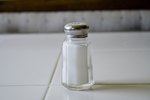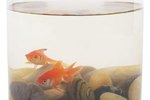
An aquarium may develop a hard white film around the top of the glass that can seem impossible to remove. For obvious reasons -- they're extremely toxic -- you can’t use household cleaning chemicals in an aquarium. But you can remove the white buildup. Afterward, prevention is straightforward.
White Deposits
The white deposits on the rim occur as water evaporates, leaving calcium or salt minerals. In a freshwater tank, calcium remains; in a saltwater or brackish tank, it could be either. Any deposits below the water line are calcium. Salt deposits come away with wetting and a little scrubbing, but you’ll probably need to dismantle the tank for the removal of calcium. Often called lime, this is the same stuff that builds up in a kettle in areas with hard water.
Removal of Salt
Remove some of the water as you normally do for routine water changes, and tackle the salt while the water level is well below the deposits. Dampen a paper towel or clean sponge with dechlorinated water, blot the salt and leave it for a few minutes. Scrub and sponge it away, taking care that most of it doesn’t fall back in the tank -- a little shouldn't change the salinity much. Replace the water as normal.
Removal of Calcium
Dismantle the tank completely, transferring any remaining aquatic pets to another fully cycled aquarium in the same manner as you would when bringing new ones home. Sponge the calcium deposits with white vinegar and let it sit for an hour. Scrub and repeat as necessary. In the case of stubborn deposits, carefully scrape them off with a razor blade. Rinse the tank thoroughly before putting it back together and beginning the cycling process all over again. This is a good time to sterilize rocks and gravel by boiling them.
Prevention
Both salt and calcium deposits occur as water evaporates, but prevention is not complicated. First of all, confirm you're conducting sufficient partial water changes through the use of nitrite, nitrate and ammonia test kits. Nitrite and ammonia levels should be indiscernible, while nitrate should be extremely low except in certain specialized tanks. If they are fine, continue with your normal routine, but mark the water level on the outside of the glass with permanent marker or a sticker. Top up the tank with distilled water as required. Never use any other water to replace that lost through evaporation, as this would lead to the buildup of minerals in the tank water, possibly to lethal levels.
References
Photo Credits
-
Jupiterimages/Photos.com/Getty Images
Writer Bio
Judith Willson has been writing since 2009, specializing in environmental and scientific topics. She has written content for school websites and worked for a Glasgow newspaper. Willson has a Master of Arts in English from the University of Aberdeen, Scotland.




